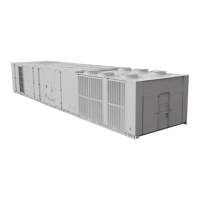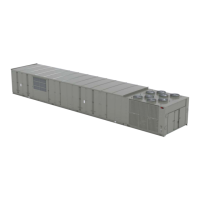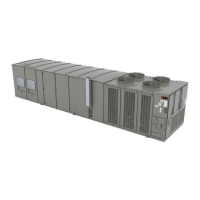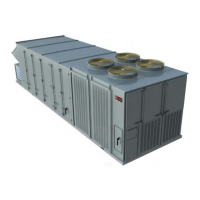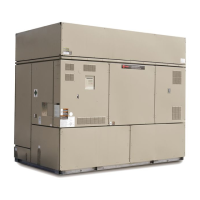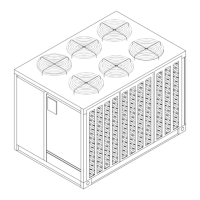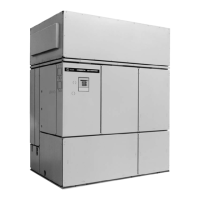Unit Start Up
148 RT-SVX36K-EN
superheat could cause serious compressor damage due to
refrigerant floodback.
Tables are based on outdoor ambient between 65° & 105°F,
relative humidity above 40 percent. Measuring the
operating pressures can be meaningless outside of these
ranges.
Measuring Superheat
1. Measure the suction pressure at the suction line gauge
access port located near the compressor.
2. Using a Refrigerant/Temperature chart, convert the
pressure reading to a corresponding saturated vapor
temperature.
3. Measure the suction line temperature as close to the
expansion valve bulb, as possible. Use a thermocouple
type probe for an accurate reading.
4. Subtract the saturated vapor temperature obtained in
step 2 from the actual suction line temperature
obtained in step 3.The difference between the two
temperatures is known as “superheat”.
When adjusting superheat, recheck the system subcooling
before shutting the system “Off”.
Note: If unit includes the modulating reheat
dehumidification control option, adjust superheat
only in the cooling mode of operation.
Charging by Subcooling
The outdoor ambient temperature must be between 65°
and 105° F and the relative humidity of the air entering the
evaporator must be above 40 percent. When the
temperatures are outside of these ranges, measuring the
operating pressures can be meaningless.
Do not attempt to charge the system with the low ambient
dampers and/or hot gas bypass operating (if applicable).
Disable the low ambient dampers in the “Open” position
(refer to the “Low Ambient Damper” section) and de-
energize the hot gas bypass valves before taking
performance measurements.
With the unit operating at “Full Circuit Capacity”,
acceptable subcooling range for air-cooled condenser
units is between 10°F to 18°F. For evaporative condenser
units, acceptable subcooling ranges is between 8°F to 14°F.
Note: If unit includes the modulating reheat
dehumidification control option, adjust subcooling
only in the cooling mode of operation.
Measuring Subcooling
1. At the liquid line service valve, measure the liquid line
pressure. Using an R-410A pressure/temperature
chart, convert the pressure reading into the
corresponding saturated temperature.
2. Measure the actual liquid line temperature as close to
the liquid line service valve as possible.To ensure an
accurate reading, clean the line thoroughly where the
temperature sensor will be attached.After securing the
sensor to the line, insulate the sensor and line to isolate
it from the ambient air. Use a thermocouple type probe
for an accurate reading.
3. Determine the system subcooling by subtracting the
actual liquid line temperature (measured in step 2)
from the saturated liquid temperature (converted in
step 1).
Low Ambient Dampers
Operation
Low Ambient Dampers are available as a factory installed
option on 20 - 75Ton units or can be field-installed.
Dampers are used to extend the operation of these units
from the standard operational temperatures to a
minimum of 0° F without hot gas bypass or 10° F with hot
gas bypass. (These values apply when wind speed across
the condenser coil is less than 5 m.p.h. If typical wind
speeds are higher than 5 m.p.h., a wind screen around the
unit may be required.) By restricting the airflow across the
condenser coils, saturated condensing temperatures can
be maintained as the ambient temperatures change.
The low ambient modulating output(s) on the compressor
module controls the low ambient damper actuator for
each refrigerant circuit in response to saturated
condensing temperature.
When the head pressure control has staged up to fan stage
2 or 3, the modulating output (0 to 10VDC) will be at 100%
(10VDC). When the head pressure control is at fan stage 1,
the modulating output will control the saturated
condensing temperature to within the programmable
“condensing temperature low ambient control point”.
The followingTable gives the minimum starting
temperatures for both “Standard” & “Low” Ambient
units. Do not start the unit in the cooling mode if the
ambient temperature is below the recommended
operating temperatures.
Damper Installation
When a unit is ordered with the low ambient option (i.e.,
Digit 19 is a “1” in the model number), a damper is factory
Table 60. Minimum starting temperatures for air-cooled
units
(a)
(a)Minimum starting temperatures for Evaporative Condenser units is
40
°F without a sump heater and 10°F with a sump heater.
Unit Size
Minimum Starting Ambient
(b)
(b)Min. starting ambients in °F and is based on unit operating at min.
step of
unloading & 5 mph wind across condenser.
Low Ambient
Standard
(c)
(c) With or Without HGBP
with HGBP without HGBP
20 & 40 55° 10° 0°
25 & 30 50° 10° 0°
50, 55 35° 10° 0°
60 30° 10° 0°
70-130 45° 10° 0°

